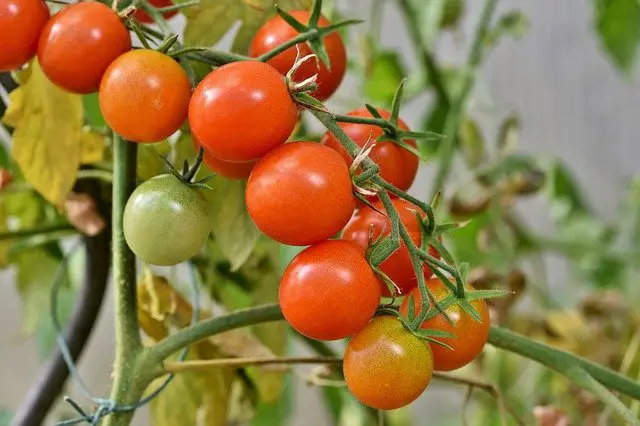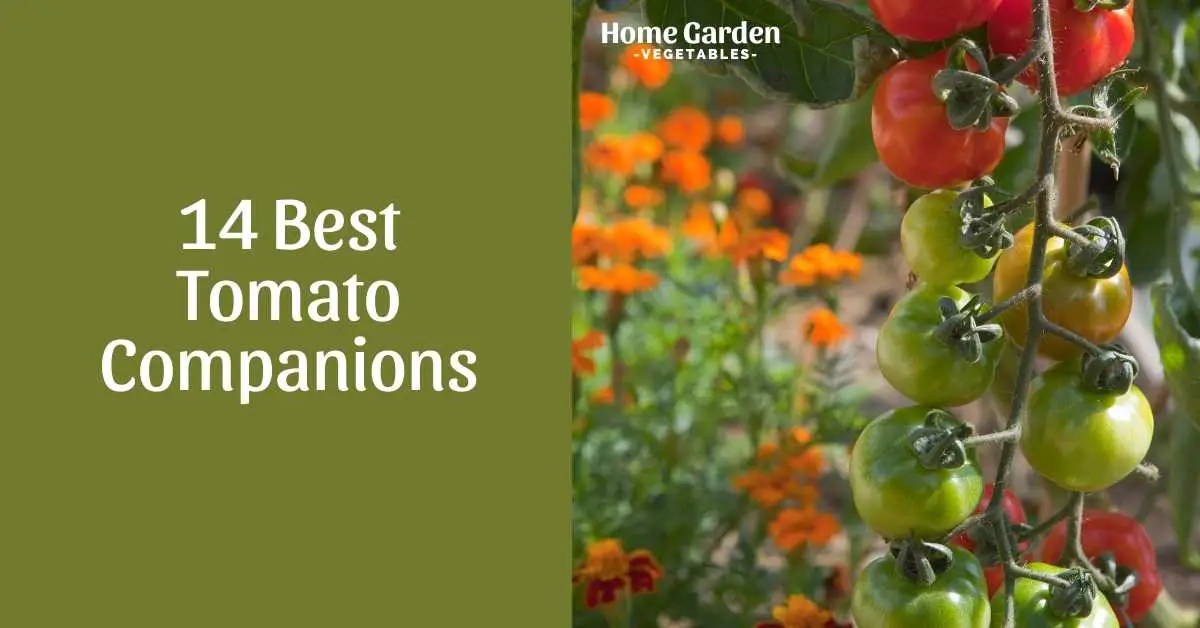Companion planting is a major aspect of gardening, based partly on science and partly on customs. Some plants do well when planted together, and then there are also plants that shouldn’t be planted together. Tomato companions planting is a great way to get multiple benefits in one go.
Tomatoes are widely popular in home gardens, and it helps to know which plants work well with them. Other than improving growth and repelling pests, growing friendly plants together also helps you make the most out of the small space you have – something that urban gardeners will appreciate most.
Reader Poll: What online courses would interest you?

Tomato companions
Different tomato companions offer different benefits. They enhance growth, provide more flavor to the fruit, assist pollination, and protect the tomato plant against pests and insects. Additionally, they bring diversity to your garden.
Planting some additional friendly vegetables means you can bring more organic variety to your dinner table; planting flowers alongside tomatoes is a treat for the eye and also for the pollinators.
Choosing the right plants to grow next to your tomato crop helps you make the most out of companion planting while choosing the wrong ones can do more harm than good.
Subscribe to our newsletter!
Vegetables as Tomato Companions
Peppers
All kinds of peppers are excellent companions to your tomato plant. Sweet and hot peppers do not benefit the tomato plant in particular, but since both types of plants belong to the nightshade family, they go along well in the same garden. Also, since both require similar care, and have similar sunlight and watering requirements, it’s simpler for you to tend to them in the same garden bed.
This 8 pack of seeds is great value and is a hot seller because it has the perfect mix of hot and sweet peppers.
Lettuce
Planting lettuce or other leafy greens in the same bed as tomatoes benefits both the varieties equally. While lettuce benefits from the shade offered by the taller tomato plants, the tomato plant, in return, benefits from the moisture retention provided by lettuce. Lettuce serves as a living mulch for your tomato plants, holding moisture and keeping the soil cool. It also prevents the spread of diseases.
When growing Lettuce don’t forget to cover and protect from birds. This lightweight netting is perfect and sizable for most backyard plots measuring 13ftx 33ft.
Carrots
Carrots do really well with tomato plants. You can plant them while the tomato plants are still young. They will grow together in harmony and will be ready for harvest around the time the roots of the tomato plant starts to spread. Although carrots don’t offer any distinguished benefits to the tomato plants, this companion planting offers an excellent solution to adding diversity even if you’re short on space.
I tend to grow tomatoes and carrots in fabric pots because these are not only great value but they also are deep enough to give the roots the space they need. A 5 gallons they are plenty big enough and have sturdy handles so you can easily move once planted.
Garlic
Garlic and all other members of the allium family do well with tomatoes. They give off a strong odor that repels insects and pests, especially spider mites and aphids. Hence, planting garlic alongside tomatoes can save your tomato crop from a disaster.
This softneck garlic variety is easy to grow and great tasting. If you love your garlic these will pair really well with tomatoes in many recipes.
Onions
Onion is another member of the allium family, and therefore, offers similar benefits to your tomato plant. Along with pests, they also repel beetles, snails, and slugs, protecting tomato plants from much trouble.
Don’t forget to fertilize well. Companion planting is fantastic and has a host of benefits but a good quality fertilizer will do wonders. Don’t let your hard work go to waste add fertiliser regularly to keep your vegetable plants healthy.
Asparagus
Asparagus and tomatoes don’t only make the perfect combo for your salad, but also for your vegetable garden. When planted alongside each other, they offer mutual benefits. Asparagus repels nematodes to protect the tomato crop, while tomatoes return the favor by warding off asparagus beetles. They also prevent the growth of weeds, making sure that they are the only ones benefiting from the nutrient-rich soil.
Herbs as Tomato Companions
Parsley
Parsley offers good companionship to tomatoes, warding off pests, improving the growth of the tomato plant, and enhancing flavour.
Mint
Mint gives off a fragrance that effectively deters pests and insects, keeping your tomato crop safe. Also, they offer good ground cover by spreading around the tomato plant base
Borage
Among other pests and insects, borage repels tomato hornworms. The added benefit is the great addition that they make to salads and soups
Basil
Basil and tomatoes make a delightful combination on the plate and a strong partnership on the ground, warding off insects and diseases. Basil is good at scaring away tomato hornworms, mosquitoes, and flies. In addition, planting it alongside tomatoes helps bring out the flavor of both. Since both plants will develop at about the same rate, you can harvest and enjoy them at the same time.
Sage
Sage is another popular herb consumed both dried and fresh. Since it gives off a strong scent, it will keep the bugs away from your tomato crop. By planting them around the edges of the container in which you plant tomatoes, you’ll protect your precious crop from pest attack
Flowers as Tomato Companions
Marigolds
Marigolds repel a variety of pests for tomatoes. They release chemicals that are especially effective in eliminating root-knot nematodes to prevent damage to your tomato crop.
Calendula
Calendula is similar to marigold in appearance and grows well with tomatoes. However, it does not repel any insects for tomatoes, unlike marigolds.
Nasturtiums
Nasturtiums are usually planted close to tomatoes, offering a tempting alternative for pests like aphids to feast on, rather than your treasured tomatoes. Additionally, the leaves and flowers are edible – another colorful addition to your tomato salad.
Tomato Companions For Achieving Different Benefits
Different companions can bring different benefits to your tomato crop. While warding off pests and insects is the major goal of gardeners when growing certain plants together, there are several other benefits that can be reaped out of companion planting. Intelligent plant combinations can improve soil fertility, improve pollination, encourage beneficial insects to counter pest attacks and ward off weeds.
If you have certain goals in mind when deciding on plants to grow with tomatoes, here are some suggestions:
- Tomato Companions For Pest Control
Pests are often a problem when growing these sweet, juicy vegetables. Thyme and basil are two herbs that you can plant around your tomato plants to deter pests. Research has found a reduction in egg-laying behavior of common pests like hornworm and armyworm when these plants are grown in the vicinity. Certain plants drive away pests from tomatoes by attracting them towards themselves and acting sacrificially. These include cowpeas, collards and radishes. Harlequin bugs, for instance, will rather go for collards than attack your tomatoes.
- Tomato Companions For Improved Pollination
Though tomato plants are self-fertile, help from bees and insects increases pollination even further. For a tomato crop, the presence of bumble bee population can be a huge blessing. Their vibrations can knock the pollen loose for improved pollination and better fruit set. Having flowering plants like sunflowers, beans, coneflowers and red clovers are some of the favorite plants of bumble bees and can increase their population in your tomato garden.
- Tomato Companions For Reduced Diseases
Fungal diseases are a common problem with tomato plants. Certain plants can help reduce diseases in tomato plants. Gardeners often grow a thick cover of sweet potato plants on the soil around the tomato plants. The dense cover prevents rain and irrigation water from splashing up the tomato stems, reducing the risks for many fungal diseases. Hairy vetch is an excellent cover crop to plant in the fall. Cut the plant short in spring and plant tomatoes through them. They will prevent splashes and reduce weeds to keep your tomatoes free of diseases.
- Tomato Companions for Beneficial Insects
Having beneficial insects around your tomato crop can help manage pests naturally. Growing plants like dill, fennel, cilantro and oregano welcomes a host of good bugs to drive away the bad ones. The blooms from these plants offer nectar and pollen for a variety of beneficial bugs, including lacewings, ladybugs, parasitic wasps and more.
- Tomato Companions For Weed Control
You can also grow certain tomato companions for minimizing weeds. Winter rye is a good cover crop to grow in the fall. At springtime, you can cut down the cover crop, and grow tomato transplants in its residue to reduce the possibility of weeds. Oats work in the same way. Crimson clover can be grown as a living mulch around the tomato plants to prevent weeds.remember to cut it back before they bloom and drop seeds.
Plants to avoid
Not all plants go along well with tomatoes. Some can harm your tomato crop; remember to plant them far apart.
The Brassica family is a popular enemy of your tomato crop. These include broccoli, Brussel sprouts, and cabbage.
Corn is another harmful companion since it attracts tomato fruit worm, corn worm, and other pests.
Dills are harmless during the initial stages of plant development, sometimes even beneficial since they ward off hornworms. However, as they grow, they hinder the growth of tomato plants. It’s best to plant them at least a little distance away from your tomatoes.
Make sure your tomato crop isn’t planted close to any walnut tree. The tree produces a chemical called juglone, which hampers the growth of tomato plants.
Fennel, eggplant, and potatoes shouldn’t be planted close either.
Conclusion
Now that you know which plants partner well with tomatoes and which don’t, you can plan smart companion planting this season. Grow friendly crops together to enhance the yield and make most out of the piece of land you have.

